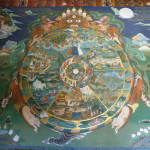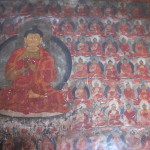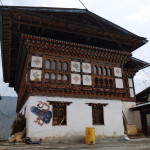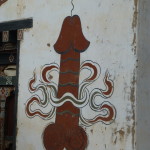
The Tibetan branch of Buddhism starts about the 8th century with Guru Rinpoche, the most revered of the Buddhist teachers, then was imported into Bhutan by him and his disciples shortly thereafter.

Over time its devotees evolved a vivid imagery to represent the complex ideas of the philosophy both in holy texts and also on the walls of temples and monasteries. These images include the mandala in its many variants as paths to enlightenment, myriad demonic and idealized manifestations of Buddha to convey different attributes, the essential six-part wheel of life, plus richly varied, symbolic tantric images of coupled male and female figures.

To the Western eye, these images can be eye-catchingly beautiful, particularly in their usual location inside the colorful prayer halls. But, viewed literally, they are just as likely to seem wildly exotic and somewhat crazy.

When you walk into any monastery, where monks or nuns are pledged to chastity, you’ll find paintings and statues of intense sexual union adorning the walls. Even the obsessive repetition of Buddha images, often in the hundreds and even thousands, can feel somewhat delirious.

For adherents, none of this feels out of place or unusual. So we were not too surprised to be hiking up to Chimi Lhakhang, a temple in the old capital of Punakha dedicated to a monk even the Bhutanese called crazy, the “divine madman” Drukpa Kuenley. He died at age 75 in the early 16th century after a lifetime of what some might consider debauchery. Among his other predilections (wine, hunting, etc) he aimed to help women find enlightenment through sexual pleasure. Perhaps he aimed to emulate those tantric images on the walls.

He was said to have “crazy wisdom” because his religious understanding was deeply insightful. Even his less hedonistic teachings, often made memorable through stories and jokes, attracted a substantial following, in what today we might call a cult. His brother, a statue of whom sits next to one of the guru at the temple, struggled to continue with his lessons after the madman’s death, but he proved way too sane and sober for everyone.

Reputedly one legacy of the guru’s earthy approach to enlightenment was the unusual Bhutanese custom of celebrating the erect penis as an emblem of fertility and good fortune, as well as a path to enlightenment. Scholars dispute this popular version, instead finding the origins of phallic celebration in earlier folk or Bon religious practice.

Whatever the source, the large wreathed paintings of the phallus are common near entrances to local buildings as are long, stiff wood carvings in the corners of houses. Tourism provides its own boost to the custom, with fertility paintings and phallic souvenirs like key chains on sale everywhere.

Drukpa Kuenley himself established the small temple and monastery to which we walked. It draws contemporary followers of the guru, especially newly married or childless couples hoping for the blessing of fertility. A ramrod-straight red wood phallus greets them at the gateway. Inside, a meter-high, but more lifelike, phallic carving proudly awaits visitors who ceremoniously circle the monastery with it.

It was unlikely Drukpa Kuenley had child-bearing in mind when he taught or copulated. As he wrote, the physical practices had higher intent:
I am happy that I am a free Yogi.
So I grow more and more into my inner happiness.
I can have sex with many women,
because I help them to go the path of enlightenment.

Outwardly, I enjoy wine, women and song.
And inwardly I work for the benefit of all beings.
Outwardly, I live for my pleasure and inwardly I do everything in the right moment.
Outwardly I am a ragged beggar and inwardly a blissful Buddha.
Nonetheless, given his popular following, we half expected to find a relic of the saint’s own genitals at his temple. His penis’s name apparently was the “Thunderbolt of Flaming Wisdom.”
(Also, for more pictures from Nepal, Tibet and Bhutan, CLICK HERE to view the slideshow at the end of the Nepal-Tibet-Bhutan itinerary page.)






